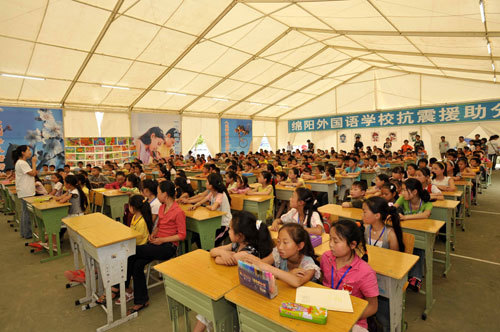
Pupils have a class in their camp classroom in Jiuzhou Stadium in Mianyang City of Sichuan Province May 23, 2008. Nearly 1,000 students from the neighboring quake-affected areas have resumed classes in the temporary camp school. [Photo: Xinhua]
The process begins
The central authorities have mobilized 20 provinces to pledge to help Sichuan build 1 million temporary houses within three months. Each house, according to the initial plan, will cover 20 sq m. By the end of June, the first batch of 250,000 such temporary houses will be provided to the quake victims. Primary and middle schools, clinics, stores, rubbish collection and water supply facilities will also be established alongside these houses.
But there are issues of bigger and longer-term significance that need to be worked out, experts say. To begin with, a comprehensive plan of reconstruction in the coming years, not months, must be mapped out and the key goals specified. A unified high-profile agency in total charge of planning and reconstruction must be put in place to avoid policy conflicts between departments.
Lessons should also be learnt from post-quake reconstruction in other countries, says Hu Angang, director of the Center for China Studies co-sponsored by the Chinese Academy of Sciences and the Tsinghua University. "International experts can be invited as advisers, who can participate in discussions and the policy consultation process for the reconstruction."
Some international organizations such as the World Bank have shown keen interest in providing their expertise in this hour of need. "We can help the local and central governments analyze the destruction and set the priorities for rebuilding," David Dollar, World Bank's country director for China, has said. "We can offer the government technical assistance. We can very quickly mobilize international experts to work with their Chinese counterparts in assessing the damage."
Reconstruction planning should be phase-based and have concrete goals, says Hu. The first phase could cover the first year of reconstruction and target the basic necessities of the victims, such as food supply, temporary housing and jobs. The second phase could cover reconstruction in the next three or five years. Ultimately, the planning should chart reconstruction in the coming decade.
Sichuan has reportedly drafted a reconstruction plan, which includes recovery of urban and rural facilities, industrial and services sectors, and geological and environmental disaster management.
If again?
A major concern in the reconstruction policymaking is the possibility of recurrence of earthquakes in the coming years. Experts say studying the local geological conditions must be given the priority in choosing the reconstruction sites.
The quake-hit regions are in the ring of fire caused by the collision of the Pacific Plate and the Indian Ocean Plate. The last major earthquake of 7.5 magnitude occurred 55 years ago in these regions. So another major earthquake within five or six decades in the same place can't be ruled out. The reconstruction, therefore, must be undertaken away from steep mountains (to avoid post-quake mudslides) and in relatively open places, says Li Kaifa, a Beijing-based urban planning expert.
Entire Beichuan, one of the worst hit counties in Sichuan, is expected to be moved to a new place. But experts are divided on how to deal with other counties and towns similarly affected and located in the seismic hot spots. Even if those counties and towns remain in their old location, their buildings will have to be made quake resistant, they say. For facilities such as schools, the standards must be set even higher than ordinary buildings.
(China DailyJune 2, 2008)